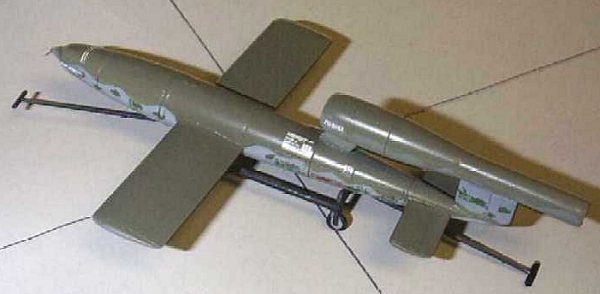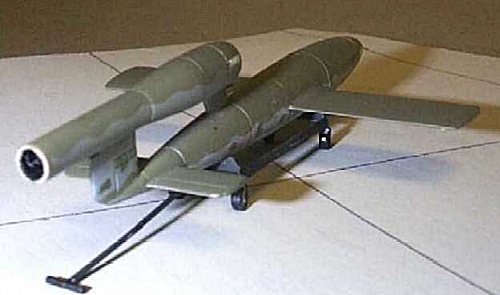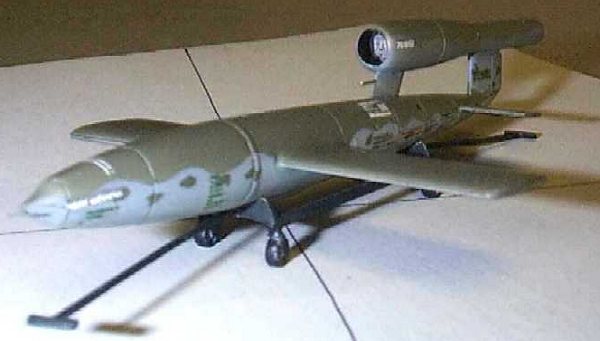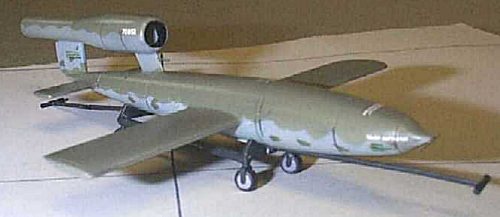
|
KIT # |
72042 |
|
PRICE: |
$14.98 ($12.96 at Squadron) |
|
DECALS: |
one missile |
|
REVIEWER: |
Pete L'Heureaux |
|
NOTES: |
Short run kit |

|
HISTORY |
For an abbreviated history from the preview from Scott, please click here. For those of you who enjoy reading about technology and history, read on!
From 1939 to early 1942, while the war was going well for the Axis powers, the Germans turned down proposals made to the RLM for autopiloted aircraft pioneered in the 1930s. However, in June of 1942, when the British were stepping up their raids on German cities by night, and with the Luftwaffe losing increasingly larger numbers of their bombers over England in an attempt to retaliate, the Luftwaffe began to look more closely at the earlier proposals. Paul Schmidt of the Argus Company, with his pulsejet had worked out propulsion for a pilot-less bomb in the early ‘30s. It was little more than a pipe, with a shutter assembly letting air in, where it was ignited by spark plugs in a combustion chamber. This action served to slam the shutters closed, with the hot exhaust escaping out the rear of the pipe, providing thrust. The Luftwaffe approved the development of a small, cheaply made rolled steel bomb with this propulsion system, with a range of about 155 miles and an 1870 lb. warhead of Triatien aluminum. It was developed by Dipl. Ing. Robert Lisser of Fieseler, with a wingspan of 17 feet, 8 inches, length of 27 feet 4 inches, a total weight of 4760 lbs., and speed after launch of 400 mph.
 The wings had no
control surfaces, were made of wood to conserve wartime material, and were
folded until preparations were made to launch. Internally, the bomb had a
Siemens gyroscopic guidance system built by Askania. Two tanks containing
compressed air served to operate the gyroscope. The guidance system was
programmed for range to target based on calculations of average speed and known
distance to target. The calculations were far more accurate than the guidance
system that used them. The vane propeller on the nose of the V-1 was set for a
preset number of revolutions, then the electrical system hooked to guidance
pitched the elevators to tilt the missile nose-down once over the target,
cutting off the fuel flow. Fuel consisted of cheap (in comparison to the
Luftwaffe’s piston driven engines’ gasoline requirements) 80-octane gasoline.
The launch ramp launching mechanism consisted of a piston driven by hydrogen
peroxide run over crystals of potassium permanganate to generate hydrogen gas
under pressure to drive the piston to propel the V-1 to flying speed. The bomb
was given the codename “Cherrystone” by the Germans. Another codename was FZG
76: Flakzielgerat 76, or “anti-aircraft aiming device 76.”
The wings had no
control surfaces, were made of wood to conserve wartime material, and were
folded until preparations were made to launch. Internally, the bomb had a
Siemens gyroscopic guidance system built by Askania. Two tanks containing
compressed air served to operate the gyroscope. The guidance system was
programmed for range to target based on calculations of average speed and known
distance to target. The calculations were far more accurate than the guidance
system that used them. The vane propeller on the nose of the V-1 was set for a
preset number of revolutions, then the electrical system hooked to guidance
pitched the elevators to tilt the missile nose-down once over the target,
cutting off the fuel flow. Fuel consisted of cheap (in comparison to the
Luftwaffe’s piston driven engines’ gasoline requirements) 80-octane gasoline.
The launch ramp launching mechanism consisted of a piston driven by hydrogen
peroxide run over crystals of potassium permanganate to generate hydrogen gas
under pressure to drive the piston to propel the V-1 to flying speed. The bomb
was given the codename “Cherrystone” by the Germans. Another codename was FZG
76: Flakzielgerat 76, or “anti-aircraft aiming device 76.”
After the first successful test flight in December of 1942 from a Fock-Wulf 200 Condor, Hermann Goering ordered units of the Luftwaffe to be trained in firing the operational V-1s toward England. One such unit was formed in August 1943, called Flakregiment 155. The antiaircraft nomenclature was again designed to mislead Allied intelligence. The new unit was commanded by Luftwaffe Colonel Max Wachtel, who had been in charge of the experimental launches. He readied his unit by firing practice from the western side of Peenemunde, on Usedom Island in the Baltic Sea. This training continued into 1944. By June, Wachtel was in France with his unit in readiness. Operations began June 13 from the Pas de Calais area, using lightweight launching ramps, 50 meters in length, because the heavier ramps were so few in number and had been vulnerable to Allied air attacks.
As the war situation became increasingly desperate for the Germans, air launches were conducted with modified Heinkel He-111 bombers from airfields in the Netherlands, but half of the V-1s launched exploded prematurely, destroying many bombers and aircrews. These air launches were abandoned by March of 1945 due to the high attrition rate and capture of forward Luftwaffe bomber airfields by the advancing Allies.
Three companies manufactured the Fi-103 “Cherrystone” through the war: Fieseler, Volkswagen, and Henschel. But a fourth, the notorious “Mittelwerk” at Nordhausen in the Hartz Mountains, was the main production site, run by the SS with slave labor.
|
THE KIT |
One sprue of dark tan colored injection molded plastic in its own plastic bag. One small brass photoetch fret. One small decal sheet. That’s all there is to this kit!! It all fits into a small box with an attractive picture of the V-1 in flight. Instructions consist of four steps with exploded drawings showing the placement of the parts, and are very straightforward. Those modelers who have a need for speed can finish this model, at least the construction part, in one afternoon and evening provided there are no interruptions or modeling disasters.
|
CONSTRUCTION |
 The parts
contain some heavy locating pins, especially on the main fuselage parts, that
if you follow the directions slavishly will leave you with large gaps upon
gluing, not to mention misalignment of the panel lines. At least this is what I
experienced with my kit. I ended up cutting these alignment pins off and
sanding them flat, and after several trial fittings, everything lined up well
for the fuselage, and the parts were glued together with Ambroid Pro-Weld liquid
cement. I left the cementing of the propulsion pipe halves with the alignment
pins in place, since dry fitting left me with no gaps and no misalignment. All
the joint seams were filled with super glue, and scraped and sanded smooth. The
wings consist of one-piece left and right parts, which attach almost butt-joined
to the fuselage, having only small shallow holes on the fuselage and tiny
plastic pins on the wings for alignment. I used Zap CA glue here.
The parts
contain some heavy locating pins, especially on the main fuselage parts, that
if you follow the directions slavishly will leave you with large gaps upon
gluing, not to mention misalignment of the panel lines. At least this is what I
experienced with my kit. I ended up cutting these alignment pins off and
sanding them flat, and after several trial fittings, everything lined up well
for the fuselage, and the parts were glued together with Ambroid Pro-Weld liquid
cement. I left the cementing of the propulsion pipe halves with the alignment
pins in place, since dry fitting left me with no gaps and no misalignment. All
the joint seams were filled with super glue, and scraped and sanded smooth. The
wings consist of one-piece left and right parts, which attach almost butt-joined
to the fuselage, having only small shallow holes on the fuselage and tiny
plastic pins on the wings for alignment. I used Zap CA glue here.
The directions would have you place the round plastic detail piece of the shutter unit before the photoetch pieces, but as this made no sense, I reversed the order after consulting with Scott. The rest of the construction was smooth sailing with no surprises and no appreciable gaps, and I completed it in two days, including the trolley for the V-1. The trolley had a few pin marks that needed repairing, but nothing taxing. But I managed to break off both the photoetched prop and pitot tube, never to be found again!! I stretched some sprue and used that as replacements.
|
PAINT & DECALS |
There are three paint schemes to choose from in the directions, and I chose the simplest, that being RLM 71 upper surfaces and RLM 65 lower surfaces. I used Model Master enamels for this over the standard MM gray enamel primer coat. Then I sprayed Testor’s Gloss Coat lacquer overall in preparation for the decals.
 The decals consist of just stencils and are very
tiny, but care in application and adherence to the instructions yielded good
results without any setting solution. After the decals had dried, I gently
wiped down the model to rid it of decal setting residue. Another coat of Gloss
Coat took care of any silvering, followed by a coat of a 50/50 mix of Dullcoat
and Glosscoat to give a matte finish.
The decals consist of just stencils and are very
tiny, but care in application and adherence to the instructions yielded good
results without any setting solution. After the decals had dried, I gently
wiped down the model to rid it of decal setting residue. Another coat of Gloss
Coat took care of any silvering, followed by a coat of a 50/50 mix of Dullcoat
and Glosscoat to give a matte finish.
After decaling, I used a dirty wash of acrylic artist’s ink to highlight the panel lines, and slightly weathered the trolley with a drybrushing of French chestnut and pastels. The model was now complete.
|
CONCLUSIONS |
This is a very enjoyable little kit to build, and it builds very quickly. Just the ticket to cure Acute Modeling Syndrome, that anxiety that occurs after tackling a particularly taxing build. A nice weekend project that builds up to an attractive model, one that I can recommend to any modeler once they get past the sticker shock for a 1:72 scale model. This model would go very well with a 1:72 scale He-111 for a project from the last months of World War II. My thanks to Scott for the review model.
|
REFERENCES |
The Internet: http://www.fiddlersgreen.net/aircraft/WWII/VI.
Also, : http://www.vectorsite.net/avcruz2.html.
Copyright Modeling Madness.com. All rights reserved. No reproduction in part or in whole without express permission.
If you would like your product reviewed fairly and fairly quickly, please contact the editor or see other details in the Note to Contributors.
Back to the Reviews Index Page 2022